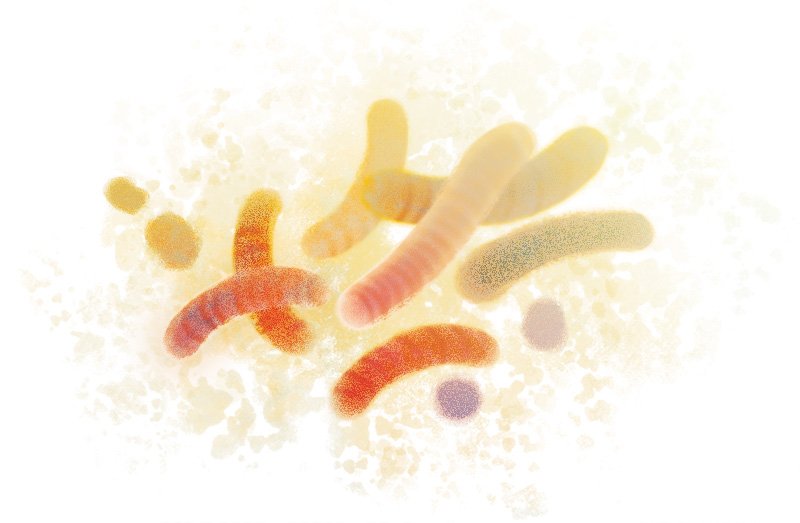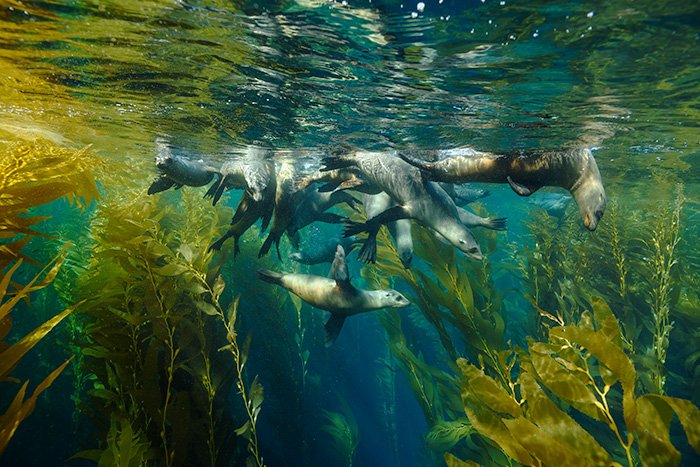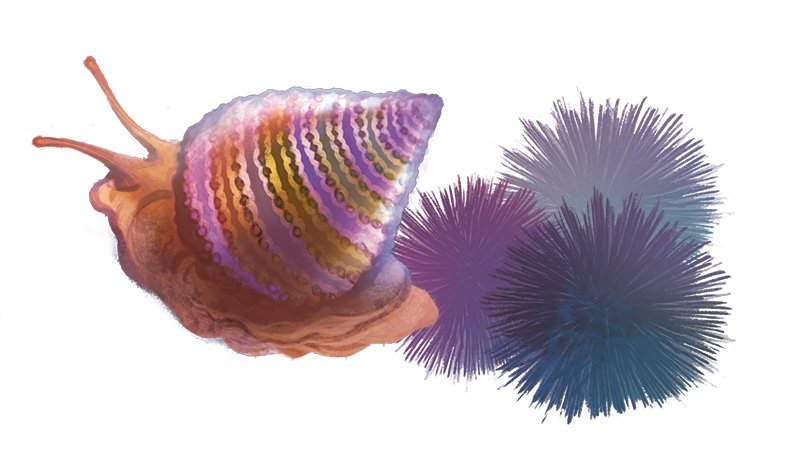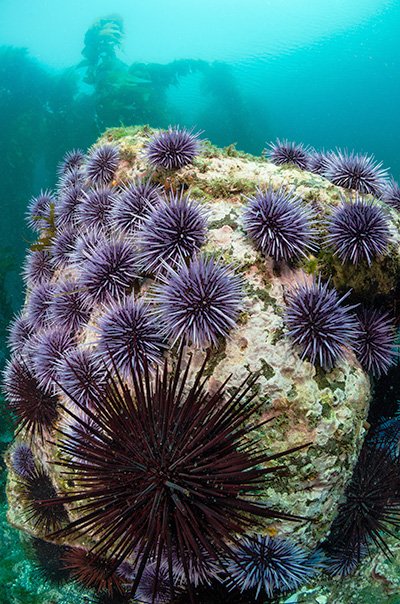
Kelp Forests—The Essentials of an Ecosystem
A host of organisms enjoy a five-star stay in one of the most intricate ecosystems on earth.
When you’re looking for the perfect hotel, you can find a lot of information on travel sites—price, reviews on the facilities and friendliness of the staff, and a list of conveniences such as free internet, breakfast, and a pool. However, what you won’t find listed are the people who make all these amenities possible. For a hotel to meet its guests’ needs and provide a safe and enjoyable environment, a full team with a variety of skills must work together to keep things running smoothly. Cooperation is key. If the custodial staff doesn’t clean the rooms, desk attendants can’t register new guests. If the manager doesn’t order food, the cook can’t make crispy bacon and fluffy scrambled eggs. If the guests don’t feel welcome, the corporation loses business. In short, unless each vital teammate does his part, the hotel will not be around for long.
This arrangement may sound like a uniquely human innovation, but hotels aren’t the only places that rely on a unified effort from a variety of contributors. Long before mankind dreamed up the hospitality business, God pioneered interdependence on a much grander scale. He created all living organisms to rely on each other in ways that benefit the organisms themselves and preserve their respective environments.
The clearest examples of this interdependence are ecosystems, communities of organisms that work together to sustain the balance of life in their environments. Forests, grasslands, and deserts are well-known examples of ecosystems. But one of the most intricate ecosystems on earth is the kelp forest. Kelp forests thrive in waters that are clear, cool, and shallow, such as those bordering the eastern Pacific coast of North America. Kelp might look like a green slimy tangle to us, but marine animals from snails to whales call these underwater ecosystems home. Like a hotel, this aquatic habitat relies on a variety of organisms to keep it running and reflects the wise management of its Hotelier, the Creator of all, through its intricately interdependent design.
A Humble Host

As the most plentiful species of kelp along the Pacific coast of North America, Macrocystis pyrifera (commonly known as “giant kelp”) serves as the primary host of this coastal ecosystem. Like any good host, this organism is not afraid to get its hands—or fronds—dirty. Kelp is designed to act as both the provider and the protector for many of the ecosystem’s inhabitants, even to the point of being their meal. Sea urchins and certain species of fish, such as the halfmoon and California sheephead, rely on giant kelp for food, while larger creatures, like sea otters and sea lions, rely on its dense underwater growth to hide them from predators such as sharks and orcas. Without kelp and its work beneath our line of vision, some of the ocean’s most-loved creatures would be in dire straits.
Giant kelp easily lives up to its name. Sometimes called the “sequoia of the sea,” this marvelous macroalgae has an average height of 100 feet and can grow up to two feet in a single day. However, unlike the sequoias in California’s redwood forests, which can continue growing for thousands of years, kelp has a lifespan of only about seven years. This may not seem like a very significant amount of time, but in those seven years, this one organism accomplishes many essential tasks for our oceans’ ecosystems and beyond.

Kelp forests grow along nearly 25% of the world's coastlines. The most prolific kelp forests flourish in the waters of South Africa, Australia, and the west coast of North and South America.
Giving Guests
Hundreds of species participate in and benefit from the kelp forest's ecosystem. In this way, these creatures have dual roles as guests and contributors. In exchange for food and shelter, they help maintain the balance necessary for kelp forests to flourish.
Bite-Size Bacteria

One of the most necessary inhabitants of the kelp forest ecosystem is also its smallest. During photosynthesis, kelp releases simple sugars into the water, a treat bacteria can’t resist. And when eager underwater microbes get the munchies, they are actually making a healthy choice for kelp and its ecosystem. After the bacteria feed off the sugars released by the kelp, they feed on the kelp as well, breaking down portions of this host organism into particles small enough for filter feeders such as colorful sea anemones to digest. A healthy amount of bacteria will not harm the kelp as a whole but instead will act as the first link in the ecosystem’s food chain. When the bacteria digest the kelp, they actually increase the carbon-to-nitrogen level in the digested particles. This provides the kelp with the nitrogen it needs to grow and flourish—nitrogen it could not have produced without the bacteria’s help.
Bacteria in the kelp forest also break down the feces of other marine life, producing even more nitrogen. This means that the same microorganisms that come to the kelp forest looking for a free buffet supply up to 73% of the nitrogen that kelp forests use to grow.

Seals are frequent visitors to kelp forests where they feed on the fish that live there.
The Deep-Sea Divas

As their name implies, jeweled top snails carry around a mobile home as flashy as a million-dollar mansion. Their bright pink and gold shells are decorated with spiraling raised “jewels,” perfectly complementing their bright golden bodies. These bedazzled beauties live on giant kelp’s stipes (the stem-like structures that sprout the kelp’s leafy blades) at an elevation equal to about half the height of the organism. This means that jeweled top snails have a magnificent penthouse view of the kelp forest. These deep-sea divas are omnivores, meaning they will eat anything from bacteria to kelp to dead fish carcasses—not exactly a five-star meal. It’s important to note that, though jeweled top snails are known to eat kelp, they do not consume it to a degree that would threaten the kelp forest’s ecosystem.
Overindulging Urchins
When sea urchins come to visit, they make themselves right at home. These sharp little echinoderms set up camp on the kelp forest floor so that, when they’re hungry, they can use their tiny tube feet to crawl just a short distance to the nearest kelp and snack on its holdfasts (root-like structures that secure kelp to rocks along the shoreline). Though urchins may sound like unwelcome guests, they play an important role in the kelp forest’s ecosystem. These creatures provide food for larger inhabitants of the forest, such as sea otters. After kelp does the job of attracting urchins to the forest, the urchins themselves attract and feed these larger creatures.
Playful Otters
Some of the best-known residents of the kelp forest are sea otters. Sea otters use the thick strands of kelp as a shield to hide from predators. Kelp forests also serve as a type of harbor where otters can wrap themselves in the vine-like fronds and prevent themselves from being tossed about by choppy waters while they sleep. Mother sea otters will even wrap their newborns in kelp to keep them from floating away.

Not only do these endearing creatures look adorable, but they also like to splash, juggle rocks, and even create natural slides to play on. However, sea otters are more than just the life of the party; they play a serious role in maintaining the kelp forest’s ecosystem. In fact, sea otters are known as a keystone species, a species without which an ecosystem would collapse. In the absence of these teddy bears of the sea, kelp forests can easily become prey to their more destructive tenants, such as sea urchins. By simply eating meals (up to 50 urchins a day), sea otters help preserve kelp forests from those insatiable echinoderms.
Other Residents
Many other essential organisms thrive within this underwater community. From fish and invertebrates—such as rockfish and top snails, which eat bacteria and provide food for larger creatures—to gigantic gray whales, which help limit the predation of sea otters by providing another food source for orcas, each resident of the kelp forest is an integral part of its balance of life.
Emergency in the Ecosystem
Just as a well-functioning ecosystem showcases God’s original relational design for his world, a failing ecosystem reveals the devastating consequences of an imbalanced world affected by sin. The California kelp forests are a particularly tragic example, as over 95% of the US West Coast’s kelp has disappeared.
In 2013, a disease called sea star wasting syndrome began annihilating the population of sunflower sea stars, primary urchin predators in the kelp forest. In the sea stars’ absence, urchins quickly took over, covering the sea floor and munching their way through the kelp. Scientists are still scrambling to discover the cause of the wasting syndrome in order to prevent the sea star species from going completely extinct and to restore balance in the kelp forests.

With dwindling otter populations, kelp-eating sea urchins go unchecked and can quickly thin out lush kelp forests.
A kelp forest without sea stars can survive as long as it has a robust otter population. Unfortunately, due to extensive sea otter hunting between the mid-1700s and the early 1900s, the California kelp forests were left with a meager population of these urchin predators, a population which has since further declined due to infectious disease and predation by other marine animals. Without sea otters, urchins’ eating habits go dangerously unchecked. As a result, sea urchins have already significantly thinned out the previously lush vegetation of the kelp forests.
Some sea urchin species can live over 100 years. With this incredible longevity, these spiny spongers can gobble up an entire forest and stick around for a second course. The wasteland left behind when a kelp forest is completely consumed is called an urchin barren.” And once these urchins ravage a kelp forest, they can go into a state of low metabolic starvation for years, waiting to devour any kelp that grows back. To halt sea urchins’ increased kelp consumption, conservationists are discussing the benefit and plausibility of relocating sea otters from other locations to the West Coast to replenish the population and restore the natural balance of the kelp forest ecosystem.
Expansive Influence
The influence of the kelp forest’s ecosystem reaches beyond the lives of its underwater inhabitants. For example, a healthy kelp forest means a plentiful catch of abalone and red urchins for the fishing industry. Kelp forests also absorb and dissipate the force of waves against the coast, decreasing erosion. Shore erosion can damage coastal buildings and disrupt the tourism industry, especially in areas with frequent storms, such as the US West Coast. Kelp’s very presence helps keep shorelines stable.
Kelp forests also play a vital role in maintaining the balance of gases in our atmosphere. Just like plants on land, kelp uses carbon dioxide from its environment for photosynthesis, transforming the carbon into organic material. In fact, kelp can absorb carbon dioxide not only from the atmosphere but also from the water. And unlike land vegetation, which releases carbon dioxide back into the atmosphere when it decays, kelp sinks to the bottom of the ocean, where it is covered in sediment. This marine sediment can trap the carbon dioxide within the kelp for decades, preventing it from being released back into the environment. In a beautiful extension of the teamwork that allows the kelp forest to flourish, this underwater ecosystem works alongside other ecosystems to help our entire planet function well.
Our Ancestor Algae?
Many modern researchers and scientists today claim that macroalgae (a larger multicellular version of typical algae, such as giant kelp) could have been the turning point in the evolution from single-celled organisms to multicellular plants and animals.
A 2019 report claimed to have evidence of this idea in the grouping together of single-celled algae to form an aggregate (collective) organism. Unlike previous instances of algae grouping together to defend itself from predators and then disbanding when the threat left, algae aggregates in this study remained together for four years after the threat was removed. Scientists claim that this instance provided observable proof of the transition between single-celled organisms to multicellular organisms. However, even if the aggregate algae were to remain interconnected forever, they would never be a true multicellular organism. Though these individual organisms were functioning as a group, they were each functioning by way of individual cellular processes.
The Bible presents us with a different explanation for the origin of multicellular organisms. Genesis 1:12 states that the earth brought forth trees on the third day—not single-celled organisms with the potential to evolve into trees, but fully formed multicellular plants. Only three days later, God created man (Genesis 1:27). No progression from algae to elm tree to man was needed to ensure that all three distinct organisms thrived on earth. There’s no need to sift through the slime of primordial algae ponds for our ancestors. You can track down your earliest family by flipping to the first few pages in your Bible.
Supernaturally Staffed
The interdependence of nature extends from the smallest molecular organism to the largest and most complex ecosystems. Each aspect of nature has been programmed by God to work alongside the others for a common purpose—to sustain life.
This beautifully complex system could never have come about by chance. All the elaborate evolutionary theories in the world could not explain such a precise and purposeful network of life—not even in a billion years. But with our knowledge of the all-wise Creator, interdependence makes perfect sense. God’s divine character, orderliness, and infinite foreknowledge allowed him to create organisms that work together like individual pieces of a global puzzle.
Creatures in ecosystems depend on each other to survive, so these interdependent relationships couldn’t have gradually developed over millions of years. With a biblical worldview, we understand that ecosystems were originally orchestrated by an all-wise Creator who designed his cosmos to flourish in a tightly knit relationship free of carnivory and imbalance.
Sadly, God’s perfect system has been tainted by the results of man’s sin, yet in his grace, God instilled in his creation the mechanisms to survive in a fallen world. Still, today, disease, excessive consumption of organisms by other species, and mankind’s failure to use the earth’s resources responsibly threaten kelp forests’ survival and could turn a thriving underwater world into a barren patch of ocean. As God-ordained stewards of creation, we have been tasked with subduing and having dominion over the earth (Genesis 1:28). This task includes understanding God’s design for unity and co-reliance in earth’s ecosystems so that we can tend them and help them recover and thrive—like caretakers of one of the finest hotels on earth.
Food for Thought
Scientific studies have shown that kelp can protect and heal the human brain. Kelp is rich in iodine, a mineral that aids cognitive development. Eating more kelp can improve memory and prevent degeneration that leads to chronic diseases such as Parkinson’s and Alzheimer’s.
Scientists have also found that injecting compounds derived from kelp into damaged brain tissue can reduce inflammation and accelerate the healing process. This discovery could lead to advances in treatment for strokes and head trauma.
You can take kelp in supplements or add it to your diet. Kelp lends a delicious umami flavor to soups and salads. You can even roast and season kelp chips for a healthy snack.
Answers Magazine
October–December 2022
Recommended Resources

Answers in Genesis is an apologetics ministry, dedicated to helping Christians defend their faith and proclaim the good news of Jesus Christ.
- Customer Service 800.778.3390
- © 2024 Answers in Genesis





